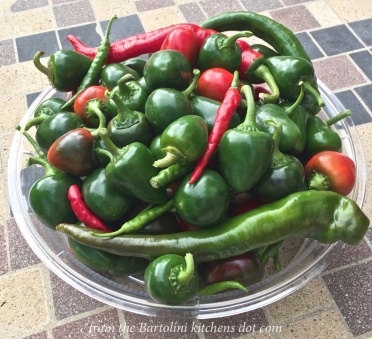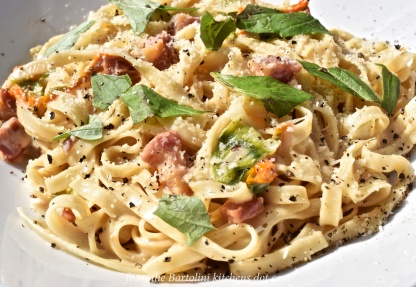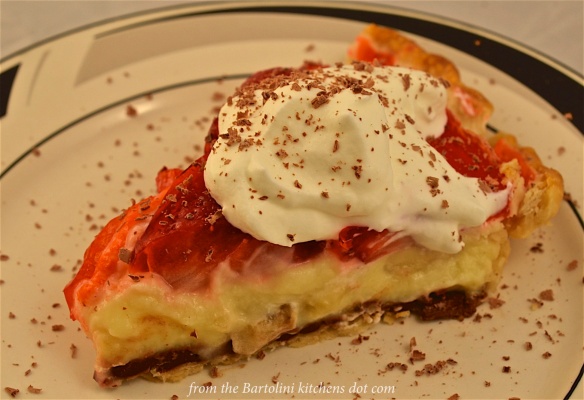
I remember this dish every year — but around Thanksgiving, long after the gardens have withered and the farmers markets have closed for the season. Sure, you can make this dish anytime but it’s best when the vegetables are freshly picked. So, what is pinzimonio?
It’s a variety of fresh vegetables served raw with a side dressing of olive oil and vinegar that’s seasoned simply with salt and pepper. (Yes, that’s crudités but I hesitate to bring a third language into the discussion.) It’s easy enough to prepare and a great way to take advantage of summer’s bounty.
* * *

* * *
When I was a boy, Mom would serve pinzimonio just about every Sunday starting in July, when the first of our garden’s crop ripened. As we gathered for dinner, there would be a platter of cut, raw vegetables in the center of the table waiting for us. You might find bell peppers, fennel, celery, carrots, radishes, cucumbers, and scallions, along with whatever caught Dad’s eye when he took Sis & I to the grocery that morning. Rounding out the antipasti/insalati, she’d also serve a platter of freshly picked, sliced tomatoes (See Déjà Vu). But wait! There’s more.
At each of our places at the table, Mom would have a ramekin with our own dipping sauce which she would cater to our age and preference. All contained oil and red wine vinegar but those for Sis and I, being the youngest, contained just a touch of salt & pepper. My brother, being so very much older (this is one way to see if my siblings read the blog), was allowed more salt and pepper in his dipping sauce. Mom, having a life-long aversion to pepper, gave herself barely a few pepper flakes with the salt in her ramekin. Dad had no such issues and you could see a thick layer of salt with another of pepper covering the bottom of his little dish. Each of us helped ourselves to whatever we wanted on the platter and dipped it into our own ramekins. No need to pass this or that and, best of all, we could double, triple, or even quadruple dip without so much as a raised eyebrow from Mom.
* * *

* * *
Now, as for a recipe, well, I’ve pretty much explained the dish already. Gather together any fresh vegetable that you would serve dressed with an oil and vinegar dressing. Clean and trim each in such a way to accommodate their serving and arrange them on a platter. Next, place oil, vinegar, salt and pepper in ramekins or small dishes, one per place setting. Although Mom always used red wine vinegar, I’ve used balsamic and loved it.
No matter the vinegar used, you’ll find that pinzimonio is a great way to take advantage of the bounty of summer, while adding more vegetables to your diet. Not only that but if, like me, you have meatless days, pinzimonio makes a great lunch or dinner, especially when summer’s heat renders the stove off-limits.
* * *
It’s déjà vu all over again …

I could hardly write about pinzimonio without offering you the link to Mom’s Tomato Antipasti. This time of year, both dishes were usually served side-by-side, much to the delight of all seated at that table. Best of all, it’s an easy dish to prepare and, like pinzimonio, no stove is required. Here’s the LINK to one of my family’s favorite summertime antipasti.
* * *
Coming soon to a monitor near you …

Butternut Squash “Noodles” with Seafood
* * *
Our Italian Holiday
This being such a short post, I thought I’d take advantage of the opportunity and share a bit of our holiday last spring.
Bologna
My trip began in Bologna, a wonderful town with an incredible history. It is home to the world’s oldest continuously operating university and the center of what many believe to be the heart of Italian cuisine. With my nephew arriving the next day, I had barely enough time to check into my room, take a walk, break my camera, have a great dinner, and get lost on my way back to the hotel. Yes, you read that correctly. My camera was out of commission for the entire trip. Let me apologize now for the quality of the pics to follow. Truth be told, I hadn’t planned on posting many because most would be very similar to those posted 2 years ago. Even so, it would have been nice to have had a good camera with me.
Many of Bologna’s walks are covered and the “pavement” is marble. The city is meant for the casual promenade. Besides several churches and the university, there are a number of sites to see: the Two Towers, the Piazza Maggiore (site of my camera’s untimely demise), the statue of Neptune, and of course, my prosciutto store, La Prosciutteria. How I love that place!!! Here are a few photos. Click on any one to see a full description.
* * *

The Two Towers

Graffiti on the Via Zamboni, adjacent to the Piazza Giuseppe Verdi

One of Bologna’s many covered walkways

Basilica of San Petronio, Piazza Maggiore, shortly after my camera’s untimely demise. (This is what results when one attempts to snap photos when angry.)

My Prosciutteria.
* * *
That day ended with one of the best restaurant meals that I was served.
* * *

Bacallà Mantecato – Salted cod whipped with a bit of olive oil, served atop burrata cream with asparagus and baby greens

Lobster Bauletti – a ravioli filled with lobster and served with a mash of peas and burrata, garnished with toasted bread crumbs

Assorted grilled vegetables
* * *
The Republic of San Marino
My nephew’s plane arrived on time and soon we were on our way to San Marino, where Zia Pina greeted us with open arms, Waiting with her was her grand-daughter & husband, and the newest member of our the family, the soon to be one-year-old Viola. Zia is a wonderful cook and the highlight was when she served cappelletti for the entire family. This just so happens to by my nephew’s favorite dish and one he hasn’t enjoyed since his Grandma, my Mom, passed away 14 years ago. The following day, she took us both for a tour of the city of San Marino, and the seat of the republic’s government atop Mt. Titano. The next day, Sunday, we attended a mass that Zia had arranged to honor our family’s departed. Afterward, we re-assembled at a restaurant In Riccione, on the Adriatic shore, for a fantastic seafood feast. I would go back there in a heartbeat! Here are just a few of those photos.
* * *

Special Delivery – Zia and her Grand-Nephew

Walking along the wall to another tower of San Marino

Piazza della Liberta with the Palazzo Pubblico, the seat of the Government.

Grand Council Chambers – San Marino

The Adriatic as seen in the distance from a parapet

The seafood feast in Riccione
* * *
Venice
Before leaving San Marino, my nephew and I “kidnapped” a young cousin for a day trip to Venice and Murano Island. It was a chilly day with showers, so, we timed our lunch and a caffè for the worst spells — or so we tried. Although we knew it was the Italian Liberation Day holiday, we didn’t know that it was also St. Mark’s feast day, he being the Patron Saint of Venice. We learned of our oversight upon setting foot upon St. Mark’s Square. Even so, we had to keep moving and, after a water taxi ride to Murano Island for a bit of souvenir shopping, we ended our day with a fine supper. Then it was a dash across Venice for a train ride back to Rimini where a cousin would take us to Zia’s. (I won’t mention that our arrival was delayed because we missed our train and, consequently, were stowaways on the next.) Thankfully, our “chauffeur” was very kind and waited patiently for our eventual arrival. These next photos are by committee. Oddly enough, each of our phones, ran out of power as we traversed Venice. Mine was the first to go, only to miraculously revive — its vibrating giving me quite a start — on the train as we approached the station in Rimini.
* * *

The western end of the Grand Canal, with the Santa Lucia Station on the right.

Church of San Giorgio Maggiore

Just another canal in Venice

Piazza San Marco

Venice Reflections
Don’t let the blue skies fool you. We were drenched by the time we reached the piazza and there wasn’t a soul seated in any of the cafés that encircle it.
* * *
Rome
The next morning, my nephew and I boarded a train bound for Rome, with Zia and 2 cousins accompanying us. What fun! Our flat was about 100 yards from the Pantheon and once we settled in, we were off for a little sightseeing around the Piazza Navona. That night, we enjoyed a fine dinner in celebration of my nephew’s graduation and, as we soon learned, my cousin’s wedding anniversary. The next morning, we walked to the Vatican to meet another cousin and her husband. Unable to get into the Vatican because the Pope was awaiting a diplomat, we took taxis to the Colosseum, stopping along the way for lunch. Well, by the time we made it to the Colosseum, it was far too crowded with tourists to enter. We headed back to the flat, said our goodbyes, and our cousins headed to the train station for their ride back to San Marino. Alone now, with only 2 days left, we planned the rest of our stay. We would spend one morning revisiting the Colosseum, with the Vatican occupying the second. The afternoons would be spent seeing everything on his “must see” list, as well as a couple of sites that I tossed into the mix. Of course, a fantastic meal would end each day.
* * *

A celebration in Rome

The Pantheon

Trevi Fountain

Lunch in Rome, our last meal together.

Temples of Saturn (l) and Castor & Pollux (r) along the Via Sacra in the Roman Forum

The Entrance to the Roman Senate

The Colosseum

Friday lunch: Pizza Montecarlo – Proof that everything is better with an egg on top.
* * *
Corinaldo
In what seemed like the blink of an eye, it was time for us to part company. My nephew returned home but a few weeks earlier I had decided to extend my holiday. I wanted to take a few days to visit Corinaldo, the Bartolini ancestral home. So, as my nephew boarded a plane, I caught a train to Ancona, where I rented a car for the drive to Corinaldo. It’s a quaint little village nestled in rolling hills. The very center of the town is totally encircled by walls that were built during the 1300s. Unlike similar towns in Italy, these walls have been maintained and are in excellent condition. There is but one entrance and one exit, the knowledge of which might have saved me the hour I spent circling the area, not to mention one ill-fated attempt of entering through the exit. (Ah! The joys of travel.) Once situated, my flat was quite nice with a terrace facing west and I was anxious to watch the sun set over the Italian countryside. Well, that was the plan but the clouds had made previous reservations, apparently, and I never did see a sunset. No worries. I still enjoyed my time there, walking from one end of the village to the other — make that “carefully walking”. It rained intermittently and the cobblestone streets are quite narrow. I rushed for a doorway or hugged a wall whenever I heard a car approach. Luckily, that didn’t happen very often. There is no rush hour in downtown Corinaldo. There is, however, a great little restaurant on The Stairs and they served me my final meal in my Grandparents’ hometown.
* * *

The terrace view
* * *

The Famed Stairs

This way for parking. Proceed with caution.

This way out.

Tartar of asparagus and broad beans with potatoes and sprouts

Tagliatellona con Ragù della Mamma

Scalloped potatoes with gorgonzola salad and goat heart
* * *
Fiumicino
I left the next morning taking a route to Ancona that would allow me to travel along the Adriatic coast for a spell. To get to the coast, I travelled along narrow roads that carried me over the hills, through the beautiful Marche countryside. I dropped off the car and made my way to the train station. With an early morning flight, my destination would be Fiumicino, a small town about 30 km outside of Rome and home to the city’s international airport. Lucky for me, there was a wonderful restaurant just down the street from my hotel. My holiday ended with one last fantastic meal, albeit a filling one.
* * *

Along the way to Fiumincino during the last train ride.
* * *

Salad of squid, calamari, octopus, crispy vegetables, vinegar, mild mustard, grapefruit, extra virgin olive oil

Munnezzaglia – various semolina paste, cannellini beans, garlic, parsley, mussel, extra virgin olive oil. (Sound familiar? It’s pasta e fagioli.)

Meatballs of angler fish & tuna, potato, parsley, marjoram, flour, cherry-like tomatoes, olive, capers, extra virgin olive oil
* * *
One thing more
Unbeknownst to me, I spent my holiday walking with a stress fracture of my left ankle. It had bothered me before I left but I made a variety of excuses about it. In fact, even upon coming home, the excuses continued. Finally, about a week later, I decided to have it checked and I was given this fancy boot to wear for the next 4 weeks. WIth the boot now gone, I am happy to say that things are back to normal, whatever that means.
* * *

You won’t find this at Ferragamo’s.
* * *
Our holiday was memorable in so many ways, and during the course of which, my now-adult nephew and I became re-acquainted. We were treated royally, with our family members freeing up their schedules so that they could spend as much time with us as possible. I’ve read that when we put to paper an objective, the odds of accomplishing it increase by 40%. With that in mind, I do not know how or when but I will be returning to San Marino. I must. I’ve promised to kidnap another cousin for a day trip somewhere.
* * *















































































































